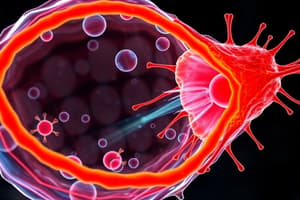Podcast
Questions and Answers
What is the primary function of the hydrophilic regions of proteins in the membrane?
What is the primary function of the hydrophilic regions of proteins in the membrane?
- To expose themselves to water (correct)
- To flip-flop transversely across the membrane
- To facilitate lateral movement of proteins
- To interact with the hydrophobic tails of phospholipids
Which of the following is NOT a function of the cell membrane?
Which of the following is NOT a function of the cell membrane?
- Regulating cell growth (correct)
- Maintaining ion concentrations of various substances
- Controlling incoming and outgoing substances
- Protecting the cell
What is the average frequency of a phospholipid molecule flip-flopping across the membrane?
What is the average frequency of a phospholipid molecule flip-flopping across the membrane?
- Once per month (correct)
- Once per year
- Once per minute
- Once per second
What is the term for the ability of the cell membrane to allow certain molecules to pass through while keeping others out?
What is the term for the ability of the cell membrane to allow certain molecules to pass through while keeping others out?
What is the main component of the cell membrane that helps to maintain its fluidity?
What is the main component of the cell membrane that helps to maintain its fluidity?
What is the primary function of the plasma membrane?
What is the primary function of the plasma membrane?
What is the term for the movement of proteins and lipids within the membrane?
What is the term for the movement of proteins and lipids within the membrane?
What is the major role of the cell membrane in maintaining homeostasis?
What is the major role of the cell membrane in maintaining homeostasis?
What is the term used to describe the ability of the plasma membrane to allow some substances to cross it more easily than others?
What is the term used to describe the ability of the plasma membrane to allow some substances to cross it more easily than others?
What is the most abundant lipid in the plasma membrane?
What is the most abundant lipid in the plasma membrane?
What is the model that describes the structure of the cell membrane?
What is the model that describes the structure of the cell membrane?
What is the term used to describe the structure of phospholipids?
What is the term used to describe the structure of phospholipids?
What is the name of the model that describes the plasma membrane as a fluid structure with a mosaic of proteins embedded in it?
What is the name of the model that describes the plasma membrane as a fluid structure with a mosaic of proteins embedded in it?
Who proposed the sandwich model of the plasma membrane?
Who proposed the sandwich model of the plasma membrane?
What is the main criticism of the sandwich model of the plasma membrane?
What is the main criticism of the sandwich model of the plasma membrane?
In a hypotonic solution, what is the concentration of solutes compared to inside the cell?
In a hypotonic solution, what is the concentration of solutes compared to inside the cell?
What is the function of the integral proteins in the plasma membrane?
What is the function of the integral proteins in the plasma membrane?
What happens to a cell in a hypotonic solution?
What happens to a cell in a hypotonic solution?
What is the direction of water movement in a hypertonic solution?
What is the direction of water movement in a hypertonic solution?
What is the result of a cell in an isotonic solution?
What is the result of a cell in an isotonic solution?
What is the main reason for water movement in osmosis?
What is the main reason for water movement in osmosis?
What is the term for the bursting of a cell due to excessive water uptake?
What is the term for the bursting of a cell due to excessive water uptake?
What happens to the cell membrane in a hypertonic solution?
What happens to the cell membrane in a hypertonic solution?
What is the main difference between a hypotonic and a hypertonic solution?
What is the main difference between a hypotonic and a hypertonic solution?
What is the primary characteristic of passive transport?
What is the primary characteristic of passive transport?
What is the net direction of solute movement in diffusion through a membrane?
What is the net direction of solute movement in diffusion through a membrane?
What is the purpose of proteins in facilitated diffusion?
What is the purpose of proteins in facilitated diffusion?
What is the state of the molecules in a system at equilibrium?
What is the state of the molecules in a system at equilibrium?
What is the primary difference between simple diffusion and facilitated diffusion?
What is the primary difference between simple diffusion and facilitated diffusion?
What is the result of diffusion continuing until all molecules are evenly spaced?
What is the result of diffusion continuing until all molecules are evenly spaced?
What is the characteristic of molecules that allows them to move from an area of high concentration to an area of low concentration?
What is the characteristic of molecules that allows them to move from an area of high concentration to an area of low concentration?
What is the term for the movement of molecules from an area of high concentration to an area of low concentration?
What is the term for the movement of molecules from an area of high concentration to an area of low concentration?
What is the primary driving force for osmosis?
What is the primary driving force for osmosis?
In a hypotonic solution, what happens to the cell?
In a hypotonic solution, what happens to the cell?
What is the term for a solution that has the same concentration of solutes as the cell?
What is the term for a solution that has the same concentration of solutes as the cell?
What happens to the cell in a hypertonic solution?
What happens to the cell in a hypertonic solution?
What is the role of solutes in osmosis?
What is the role of solutes in osmosis?
What is the term for the movement of water across a selectively permeable membrane?
What is the term for the movement of water across a selectively permeable membrane?
What is the result of a cell in an isotonic solution?
What is the result of a cell in an isotonic solution?
What is the term for the state of equal water movement in both directions across a membrane?
What is the term for the state of equal water movement in both directions across a membrane?
Flashcards are hidden until you start studying
Study Notes
Cell Equilibrium and Osmosis
- In a state of equilibrium, water flows in both directions across the cell membrane, and solute and water concentrations are equal inside and outside the cell.
- Hypotonic solution: has a lower concentration of solutes and a higher concentration of water than inside the cell, resulting in water moving into the cell, causing it to swell and potentially burst (cytolysis).
- Hypertonic solution: has a higher concentration of solutes and a lower concentration of water than inside the cell, resulting in water moving out of the cell, causing it to shrink (plasmolysis).
Cell Membrane Structure and Function
- The plasma membrane is a selective barrier between the cell and its surroundings, controlling the movement of substances in and out of the cell.
- Phospholipids are the most abundant lipid in the plasma membrane, and are amphipathic molecules with hydrophobic and hydrophilic regions.
- The fluid mosaic model describes the plasma membrane as a fluid structure with embedded proteins, allowing for selective permeability.
Functions of Membranes
- Protect the cell
- Control the movement of substances in and out of the cell
- Maintain ion concentrations and homeostasis
- Selectively permeable, allowing some molecules to pass through while keeping others out
Phospholipid Bilayer and Fluidity
- Phospholipids in the plasma membrane can move laterally within the bilayer
- Rarely do molecules flip-flop transversely across the membrane
- The fluidity of the membrane allows for the lateral movement of lipids and proteins
Transport Across Membranes
Passive Transport
- Diffusion: the random movement of particles from an area of high concentration to an area of low concentration
- Osmosis: the diffusion of water across a selectively permeable membrane, moving from high to low water concentration
- Facilitated diffusion: the use of proteins to carry polar molecules or ions across the membrane
Active Transport
- Requires energy from the cell
- Examples include protein pumps, endocytosis, and exocytosis
Studying That Suits You
Use AI to generate personalized quizzes and flashcards to suit your learning preferences.





